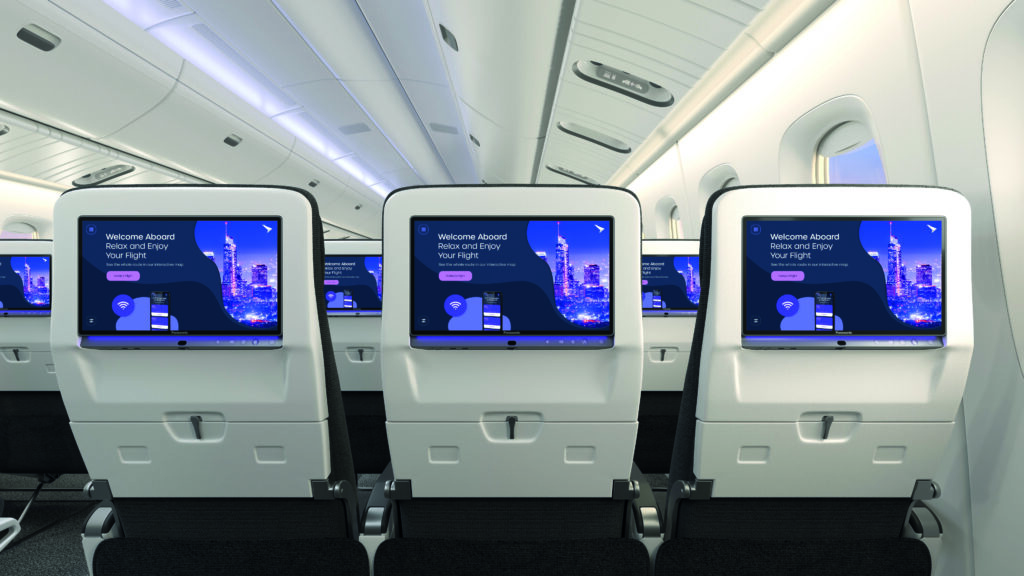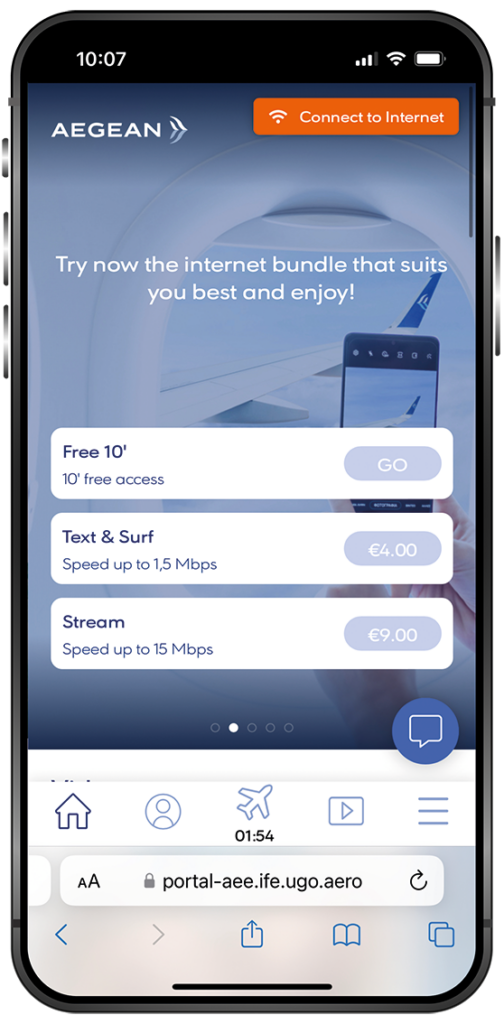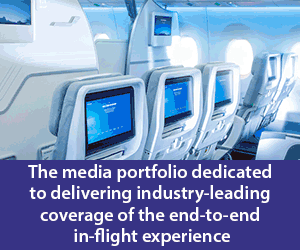As one of the most vital passenger touchpoints, innovative in-flight entertainment (IFE) systems are on the wish lists of countless airlines looking to level up the passenger experience on board. Elena Lodge learns about some of the solutions on offer and why they’re fitting the bill.
Six hours and 58 minutes is the average screen time per day for users of electronic devices worldwide, according to 2023 insights from Exploding Topics. That’s more than a quarter of every day – about the same time spent during a decent night’s sleep. For most, this may cause alarm. For an airline, however, it presents an opportunity.
Our lives have become intrinsically linked to our mobile phones and laptops, tablets and televisions, e-readers and audiobooks. The prospect of entering a digital blackout when flying just won’t cut it any more. Passengers expect to have the same digital dependency in the air as on the ground – and at the same quality.
Enter in-flight entertainment (IFE). It has been installed in aircraft cabins for a long while, yet the continual evolution of passenger expectations has moved the goalposts. IFE increases customer engagement and improves passenger loyalty levels, as well as the airline’s net promoter score (NPS). For this reason, investing in IFE and connectivity (IFEC) is a no-brainer for carriers.
So what are some of the IFEC solutions on offer, and what are they doing to bring a quality digital experience that meets the upped expectations of airline customers?
Great expectations
The increase in passenger requirements is currently a hot topic of conversation for all industry stakeholders. This shift has been largely caused by the disruption to typical practices during the unprecedented years in the throes of the Covid-19 pandemic.

Representing an opportunity for airlines, IFE increases customer engagement and improves passenger loyalty levels, as well as the airline’s net promotor score (NPS) Source: Panasonic Avionics
Andy Masson, Vice President of Product Management, Panasonic Avionics Corporation, has some thoughts on this.
“The global pandemic had some real ramifications for passengers’ expectations,” he says. “As we all started working from home, we became more and more acclimated to having multiple devices open. [People] had several screens open at once and that’s what they expect today when they fly.”
Based on these developments, airlines have been pressured to source multi-purpose screen solutions capable of delivering engaging, flexible entertainment for passengers.
Panasonic Avionics has an extensive product portfolio consisting of In-Flight Systems, In-Flight Connectivity, Digital Solutions and Technical Services.
The IFEC provider has more than 15,000 solutions installed on aircraft, with its connectivity solution installed on more than 2,000 aircraft. Its popular IFE product line, Astrova, is a particular favourite among airline customers and is used across economy, premium economy, business, super business and first-class cabins.
During last year’s Aircraft Interiors Expo in June, Panasonic announced five new screen sizes, bringing its entire Astrova portfolio to include 13-inch, 16-inch, 19-inch, 22-inch, 27-inch, 32-inch and 42-inch screen size choices.
As well as adding multiple screen size options, Panasonic is encouraging the use of multiple screens at once. Passengers can seamlessly interface personal electronic devices (PED) with the Astrova IFE system, creating a multi-screen, multi-purpose environment. This is supported by the new capability to simultaneously charge multiple devices, according to Masson.
“As an industry first, the IFE will provide up to 100W of USB-C power to fast-charge multiple passenger devices at a time, including notebooks and laptops,” he says.
Panasonic Avionics’ Astrova is also factoring in rising passenger expectations in other ways by evolving key hardware and software components over time, notes Masson. An example of this is the removable peripheral bar allowing airlines to easily add, upgrade or remove features such as USB power and Bluetooth audio when new technologies or enhancements are made available.
“The biggest trend we see is airlines tying in their in-cabin experience with the same goals and objectives they have with their web and mobile app strategies,” Masson says, citing this as the reason for Panasonic Avionics’ focus on redefining the passenger experience and reimagining the ownership experience for its airline customers.
Screen synergy

Best of both worlds: Display Interactive are combining IFE with connectivity solutions. Source: Display Interactive
Utilising Personal Electronic Devices (PED) in the aircraft cabin is a popular strategy amongst airlines and IFEC suppliers alike, it seems. Another company implementing this strategy is Display Interactive, which is combining IFE with connectivity solutions.
Display Interactive has a product portfolio of browser-based portals, capable of supporting all PEDs and available as retrofit options for aircraft. Each of its solutions is integrated on Airbus Airspace Link, Airbus’s standardised onboard digital platform.
UGO PAX is Display Interactive’s STC-certified end-to-end solution for wireless IFE service, used on non-connected aircraft.
With UGO PAX, passengers have access to entertainment and infotainment features such as moving maps for children, passenger surveys and ancillary services, all delivered in high resolution.
Display Interactive’s UGO 360 is another of its certified solutions, instead used for connected aircraft. This system’s focus lies in personalisation and ancillaries, with multiple services available – such as the eCommerce field with secured transactions, affiliate marketing or programmatic advertising.
Thierry Carmes, Display Interactive’s Chief Operating Officer, calls the combination of IFE and connectivity a natural step for IFEC.
“Connectivity services are delivered to passengers’ PEDs,” he says. “So it is a natural convergence of IFE and internet, and both services cross-fertilise.”
“A portal is attractive thanks to well-designed IFE features and this creates a funnel towards ancillaries – including connectivity.”
This cross-fertilisation allows for a seamless, more personalised experience. Airlines can tailor services, content and special offers via a single portal based on any passenger’s loyalty status, booking and travel class – and the flight route. The benefits adds Carmes, are quite tangible, with the company having noticed higher take-up and transaction rates than average, based on compiled data.
Lighter and brighter
The benefits of Display Interactive’s IFE solutions also include significant potential for scalability, fast changes and weight savings.
“It’s really hard to imagine at this stage a business class service on premium airlines without large screens on long-haul flights,” says Carmes.
“That being said, key benefits of UGO or other streaming solutions obviously include weight optimisation and fuel efficiency.”
“Our typical installation would be in the range of 15 kg on a single-aisle – while a seatback system, when you account for the screens, serves and wiring, would go up several hundred kilos.”
However, for Safran Passenger Innovations (SPI), the weight of its products has been going down, not up.

Safran can achieve up to 23% in weight reductions and 23% less power usage without affecting the passenger experience, depending on the configuration. Source: Safran
RAVE Ultra plus is the newest iteration of SPI’s RAVE in-flight entertainment system. It is powered by RAVE OS, an open software platform that allows third parties to develop applications that are seamlessly run on RAVE, giving airlines the ability to control their own IFE features.
During the development process of its RAVE Ultra plus, SPI was focused on the removal of weight from the screen.
“Our objectives were to take weight out of our system by optimising our power distribution and implementing two-wire ethernet cabling instead of eight wires,” explains Ben Asmar, Vice President, Products and Strategy.
As a result, SPI can achieve up to 23% in weight reductions and 23% less power usage without affecting the passenger experience, depending on the configuration.
Significant weight reductions weren’t the only objective on SPI’s list, with the supplier aiming for RAVE Ultra plus to provide a flexible platform for passengers – a key element of which came from the option for selection.
“An example of this is our industry-first AC power system,” says Asmar. “This allows our customers to add AC power in economy if they would still like to offer this service at a much lower cost. Then for those customers who don’t want to offer this and just want to focus on USB-C fast charging, our system can support that without carrying any unnecessary components.”
Improving the brightness and display quality of the screens was also on the agenda for the development of the new system.
The next generation of RAVE 4K Ultra High-Definition displays feature mini LED technology. Mini LED will offer exceptional brightness and contrast, as well as zone dimming technology creating truer blacks, supporting High Dynamic Range (HDR) content.
According to SPI, the “stunning” displays have received incredible feedback thus far. “RAVE Ultra plus is really resonating,” says Asmar. RAVE Ultra plus launched back in June 2023 and has since gained traction with customers who also consider sustainability as a key priority. SPI expects RAVE Ultra plus to be available in early 2025 for use on premium cabins.
Needs must
Seatbacks or streaming – is one really better than the other? Or perhaps, multi-screen in-flight entertainment may indeed prevail. Only time will tell.
Carmes says: “It is really an airline’s choice, based on its service strategy and how it is rolled out on the different travel classes, but we would definitely consider streaming as a valid option for single-aisle fleets and economy class on wide-bodies – with the relevant charge ports and device handlers.”
He notes that value-conscious airlines are already opting in to streaming solutions due to the benefits from ancillary revenues such as connectivity sales, eCommerce and affiliation.
“There is no question today that on all connected aircraft we’ll be in a PED-centric world,” he says. “Should you segregate usage between screens, or rather leverage the most popular one to provide additional services?”
As Carmes suggests, keeping up with passengers’ needs and expectations will require the IFE systems that are implemented to continue receiving updates on its services and capabilities. For example, SPI is adding an accessible interface that can be customised to individual passengers’ needs.
The RAVE OS Accessible mode, announced during this year’s Aircraft Interiors Expo in June, will provide an array of choices when the system starts up, aimed at making the individual’s user experience easier and more personalised.
The different configurations allow passengers with visual, auditory and motor function difficulties to tailor the system to their needs. The variations to the IFE include changes like language selection, screen reading function for passengers with visual disabilities, filtering content to show exclusive audio descriptions, theme colour selection and text or image-based navigation aimed at assisting passengers with cognitive disabilities. Once selected, the passenger can adjust their chosen configuration at any time.
“Instead of having accessibility features sit on top of the standard GUI (graphical user interface), this is a GUI that is customised to the needs of the passenger based on their own selections,” says SPI’s Asmar.
“All the great RAVE features will be available – we are just removing the parts that make it difficult for people with disabilities to navigate so they can get to where they need as easily as possible.”
The RAVE OS Accessible mode has received positive feedback, which has validated SPI’s direction, with the company feeling as though it on the right path.
“We know we have a good concept,” says Asmar. “However, we recognise that we need to do some further validation with people that will actually be using the system and will be doing this over the next six months.” Following this feedback period, SPI expects to launch its new Accessible mode in 2024.
This article was originally featured in the September/October 2023 Edition of Inflight. You can read the whole magazine HERE
If you’re interested in what you’ve read here, you may like these other articles.
Panasonic Avionics announces major expansion of global connectivity






